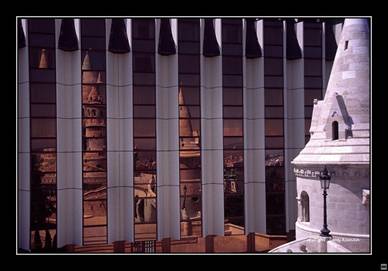Agnus Dei (2005)
For Mozart’s Unfinished Mass in C-Minor, K.427
Duration: 8 minutes
SSTB Soloists, SSAATTBB Chorus; 1020/2230/timp/org/str[perc][Handbells]
Piano/Vocal score available
A Gregorian Chant version of the uncompleted portions of the Crucifixus is included in the score
Commissioned by the Dayton Philharmonic
Premiere Performance: May 19, 2006; Dayton Philharmonic;
Neal Gittleman, Conductor
Budapest Gothic Coronation Church, Fisherman's Bastion
reflected in modern Hilton Hotel (described in Composer’s Note )
)
Review:
There was plenty to cheer: The commissioning of a work—Robert Rodríguez' Agnus Dei—that not only complemented and 'completed' Mozart's unfinished Mass...but will certainly have continued life as part of the symphonic repertoire.
Dayton Daily News
Composer’s Note:
Agnus Dei (2005) for Mozart’s unfinished Mass in C-Minor, K.427 was commissioned by the Dayton Philharmonic Orchestra with the assistance of the National Endowment for the Arts. The premiere performances were conducted by Neal Gittleman on May 19 and 20, 2006 as part of the orchestra’s celebration of the 250th anniversary of Mozart’s birth. The work is scored for the same forces as Mozart’s mass, including flute, which Mozart uses only in the Et incarnatus est, with additional timpani, chimes and handbell choir.
Scholars have long debated why Mozart never completed this masterpiece. We know that the work was not commissioned, but was, instead, Mozart’s gift of thanks to God on the occasion of his marriage to the soprano Konstanze Weber. It is possible, however, that Mozart’s gift was actually designed more to appease his earthly father, Leopold, who opposed the marriage. Once Mozart had begun the mass and had married Konstanze, Mozart could well have assumed that he had sufficiently proved his point to Leopold concerning the seriousness of his intentions. Also, since there was no pressing financial need to finish the mass, it was logical for Mozart to have set it aside in order to devote his time to more revenue-producing projects as he began married life. Another explanation often cited is that soon after the wedding came the birth and death of the Mozarts’ first child.
For me, the most fascinating part of the story was the fact that Mozart’s marriage to Konstanze was on the rebound from his rejection by Konstanze’s sister, Aloysia Weber, also a soprano. It seemed to me more than a coincidence that the mass should be scored, not for the traditional soprano and mezzo-soprano, but, instead, for two sopranos, along with tenor and bass soloists. I was especially struck by the dueling nature of the two high and equally-demanding soprano parts, particularly in the Domine Deus. I, therefore, decided early on to feature the two soprano soloists in my Agnus Dei in a similarly dramatic and competitive trade-off of musical material.
Another lingering question about Mozart’s mass concerns what provisions were made for its missing portions (parts of the Credo and the entire Agnus Dei) at the Salzburg premiere, at which Konstanze performed. We can surmise either that Mozart interpolated movements from his earlier masses or that he used Gregorian chant or that he assembled a combination of the two. The idea of Gregorian chant I found appealing, since Mozart employed chant in other works, particularly in his later Masonic Funeral Music, K.477 and the Requiem, K.626. My Agnus Dei begins with a Gregorian Agnus Dei that Mozart might have used, and my choice of the handbells was inspired by the Medieval atmosphere of the chant.
Rather than attempt to write in the style of Mozart, I decided to compose in my own voice, with Mozart’s music as inspiration. I used as a visual model the skyscraper Hilton Hotel in Budapest which sits in the city’s main square opposite the Gothic Coronation Church and the neo-Gothic Fisherman’s Bastion. The two radically different styles are reconciled as the ornate stone monuments are reflected in the sleek steel/glass structure beside them. A similar architectural juxtaposition of the old reflected in the new may be seen in the Trinity Church beside the Hancock Building in Boston’s Copley Square and in the post-modern Pyramid which sits in the 17th-Century courtyard of the Louvre facing the ancient Egyptian obelisk in the Place de la Concorde in Paris.
In tribute to Mozart, I have cast the Agnus Dei in a modified sonata form, using quasi-tonal melodies and harmonies and Mozartian accompaniment textures. Instead of devoting long sections either to soloists or chorus, one group at a time, as Mozart does, I have chosen to bring in the quartet for shorter and more frequent appearances, in which the soloists constantly alternate with the two choruses in dramatic, antiphonal style. In addition to the Gregorian Agnus Dei, I have used three of Mozart’s own melodies from the mass: the orchestral introduction to the opening Kyrie and two themes from the closing Benedictus/Osanna (the soloists’ florid Benedictus qui venit and a fragment of violin figuration used in the closing bars of both the Sanctus and Benedictus). These “alpha and omega” references to Mozart’s original mass are heard first in their original melodic shapes. The themes are then superimposed over contrasting material and are gradually transformed as they merge with the chant into a synthesis of three stylistic worlds: Medieval, Classical and Contemporary. All themes, styles and performing forces join at the end in a tranquil, extended canonic setting of words which continue to be appropriate for our own troubled times: Dona nobis pacem.